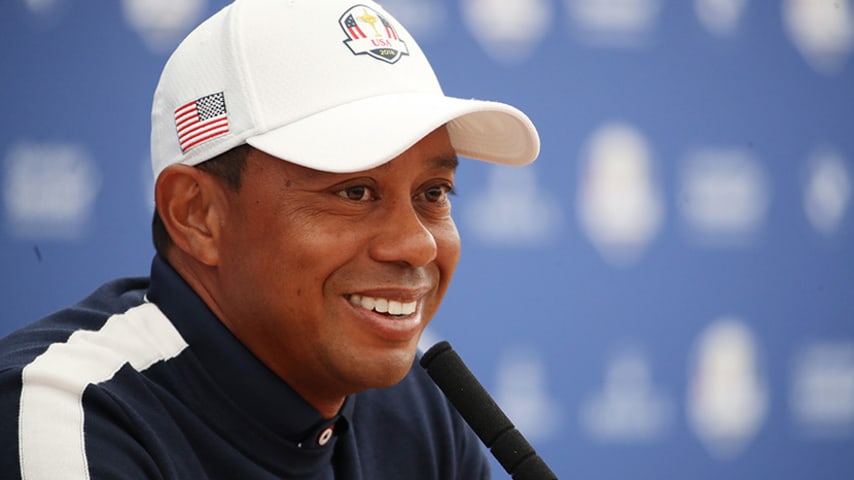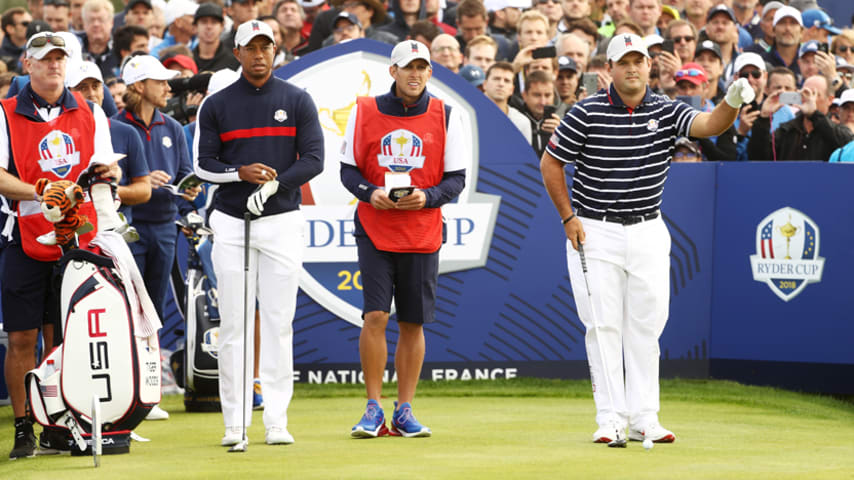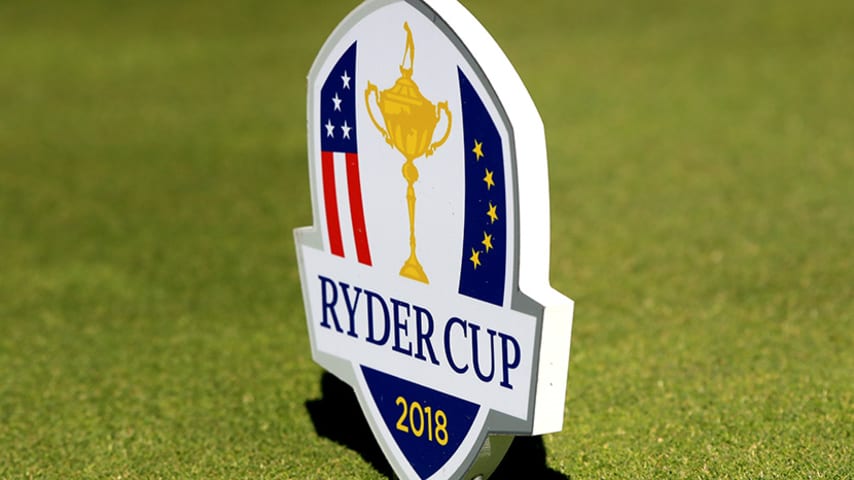Finding a Ryder Cup partner for Tiger Woods not always easy
6 Min Read

PARIS, FRANCE - SEPTEMBER 25: Tiger Woods of the United States attends a press ocnference ahead of the 2018 Ryder Cup at Le Golf National on September 25, 2018 in Paris, France. (Photo by Christian Petersen/Getty Images)
Written by Cameron Morfit

Act III, Part 14: Tiger Woods wins the TOUR Championship
Tiger Woods and Mark Calcavecchia were never supposed to play in Foursomes (alternate-shot) at the 2002 Ryder Cup at The Belfry. Birdie-machine Calcavecchia seemed more appropriate for Four-ball play, but two things led to the Tiger-Calcavecchia pairing.
First of all, they were friends, having played practice rounds together, and “Calc” wouldn’t be intimidated by Woods’ aura. And secondly, there was something Calcavecchia knew that U.S. Captain Curtis Strange didn’t, or at least didn’t seem to take into account: Playing with Ken Green and Payne Stewart, Calcavecchia had gone 4-0 in previous Ryder Cup Foursomes.
“I actually had to talk Curtis into it,” Calcavecchia said recently. “I brought it to his attention. I said, ‘Let me play with Tiger, I’ll get you a win.’
“I would have thought, teeing off, that there was no way we could lose.”
A lot of people have thought that way upon partnering with Tiger, who is coming off a seismic victory at the TOUR Championship at East Lake last weekend, the long-awaited 80th of his career at age 42. He is perhaps the greatest player in history, knows more about winning than anyone short of PGA TOUR victories leader Sam Snead (82), and would appear at first glance to be the perfect teammate. What could go wrong?
Plenty, as it turns out. In seven Ryder Cups, Woods has had 12 partners in Foursomes and Four-ball play, going 4-8-1 and 5-8-0 respectively, for an un-Tiger-like 9-16-1 record in the matches that make up the first two days (and 16 of 28 points) of the competition.
One of the stories heading into this week’s Ryder Cup at Le Golf National in Paris will be the U.S. Team’s effort to win on foreign soil for the first time since 1993. But to do that, U.S. Captain Jim Furyk may need to find a way to help Woods find a partner. His record in Ryder Cup Foursomes and Four-ball has been a head-scratcher, to say the least.
Woods’ frustrations certainly haven’t been for a lack of trying.
Three times, in ’99, ’02 and ’04, he has been paired with three different players in a single Ryder Cup. He settled down and went 2-2 with Furyk in ’06, and 2-1 with Steve Stricker in 2010. The Woods/Stricker tandem had been potent the previous year in the 2009 Presidents Cup, winning all four of their matches. But in the 2012 Ryder Cup at Medinah, they went 0-3 as the U.S. lost a heartbreaker.
What gives?
As it turns out, it may not be that complicated. It’s the ball -- or it was.
Although Ryder Cups in America never abide by the one-ball rule, Ryder Cups in Europe used to do just that, forcing Foursomes teams to pick a ball (brand, compression, cover softness) and stick with it for the day. Woods played a soft, high-spin ball that was unfamiliar to the rest of the TOUR, sometimes leaving his partners to try and adapt on the fly.
They didn’t always have much success. So it went for Calcavecchia as he and Woods never quite clicked at The Belfry and lost 2 and 1 to Europe’s Sergio Garcia and Lee Westwood.
“I had a problem playing with his Nike ball,” Calcavecchia recalled. “I hit a couple iron shots that I thought were perfect and came up 30 feet short. And on a par-5 on the front nine, I thought I could carry this fairway bunker and it crashed into the lip, which surprised me. I basically hit his ball 10 yards shorter than I hit my ball. It just felt softer than the Titleist I was playing.
“And neither of us played very well,” Calcavecchia added. “Tiger missed a couple 4-footers for par, which he never does, and on 14, the par-3, he half-shanked an 8-iron about 50 feet right and it buried in the corner of a bunker. I could barely get a club on it and we lost that hole. Prior to that, I’d hit a couple bad drives and put him in a bad spot. But that’s alternate-shot.”
How bad was it? Garcia and Westwood won three holes with pars.
The good news is that the one-ball rule is no longer in effect in Europe, allowing Foursomes teammates to each use their own ball off the holes where they tee off, simplifying the process. Woods, at least, believes the rule change might help him going forward, whether he’s paired with Bryson DeChambeau, as speculated, Phil Mickelson or somebody else in France this week. “Now when you're pairing guys -- a little bit more on personality than your golf ball,” Woods said. “So that's changed the alternate shot. … It's so much easier now because we're able to hit whatever we want off the tees. And that makes a world of difference.”
Both he and DeChambeau play a Bridgestone ball, albeit different models. Woods calls it, “a firmer version of what I play.” Perhaps more indicative of a potential partnership, the two have formed a rapidly growing friendship, teaming up for practice rounds and also playing together in the third round of the Dell Technologies Championship, when DeChambeau shot 63 on the way to his second victory in as many weeks to start the FedExCup Playoffs.
“If he goes around and shoots 8-under par every time, that will work,” Woods said.
Shooting 65, as Woods did twice at East Lake last week, would also work.
As for why his record isn’t better in Four-ball, more often called best ball in the States, NBC/Golf Channel commentator Justin Leonard says that’s more complicated. There’s heightened attention on anything Woods does; players are especially fired up to beat him (ask former No. 1 Greg Norman about being a target); and match play can be a fickle beast.
“I think Tiger's not easy to pair with people,” Leonard said. “Because the attention that he brings … you're expected to win, and then you're going up against the best players in (Europe), and over an 18-hole match. So, a lot of funny things can happen.”
Funny things that as Joe Pesci might say are not exactly “hah-hah funny” for the Americans.
Leonard, one of the 12 Americans who have partnered Woods, fared better than most; they halved a Foursomes match against Jesper Parnevik and Ignacio Garrido at Valderrama in 1997.
Phil Mickelson has a different theory about Woods’ woes.
“When you'd be partnered with him, you'd let him do all the work because he's so good,” Mickelson said. “And you don't get focused in on your own game and play our best golf.”
Who will be Woods’ partner in France? That might be up to Woods himself; after all, he was a Vice-Captain until Furyk tabbed him as a captain’s pick.
“Tiger tells you who he wants to play with; he’ll tell the captain,” Calcavecchia said.
You get the sense that he’s probably right, be the year 2002 or 2018. As for Woods’ partner problems, though, the one-ball rule isn’t the only thing that’s changed over the decades.
“It was a little bit different 15, 18 years ago than it is now,” Calcavecchia said, “especially with all Tiger has been through. He’s a little easier to be around. Whoever gets paired up with him, whether it’s DeChambeau or someone else, I think will feel more comfortable.”
DeChambeau already sounds comfortable.
“I don't really want to say it,” he said, “but I think maybe we can potentially intimidate a couple of people out there. I think it would be kind of cool.”
Your move, Captain Furyk.





